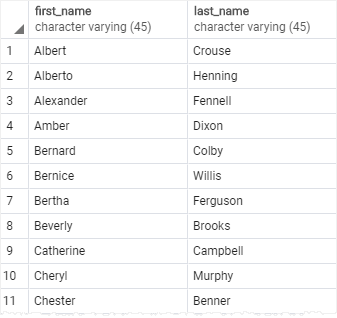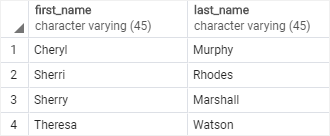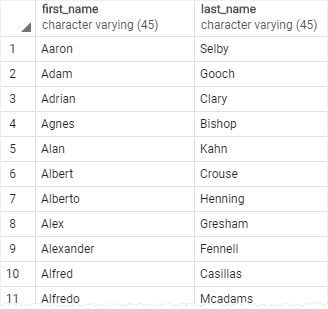August 1, 2023
Summary: in this tutorial, you will learn how to use the PostgreSQL LIKE and ILIKE operators to query data using pattern matchings.
Table of Contents
Introduction to PostgreSQL LIKE operator
Suppose that you want to find a customer, but you don’t remember her name exactly. However, you can recall that her name begins with something like Jen.
How do you find the exact customer from the database? You may find the customer in the customer table by looking at the first name column to see if there is any value that begins with Jen. However, this process can be time-consuming if the customer table has a large number of rows.
Fortunately, you can use the PostgreSQL LIKE operator to match the first name of the customer with a string using the following query:
SELECT
first_name,
last_name
FROM
customer
WHERE
first_name LIKE 'Jen%';

Notice that the WHERE clause contains a special expression: the first_name, the LIKE operator and a string that contains a percent sign (%). The string 'Jen%' is called a pattern.
The query returns rows whose values in the first_name column begin with Jen and may be followed by any sequence of characters. This technique is called pattern matching.
You construct a pattern by combining literal values with wildcard characters and use the LIKE or NOT LIKE operator to find the matches. PostgreSQL provides you with two wildcards:
- Percent sign (
%) matches any sequence of zero or more characters. - Underscore sign (
_) matches any single character.
The syntax of PostgreSQL LIKE operator is as follows:
value LIKE pattern
The expression returns true if the value matches the pattern.
To negate the LIKE operator, you use the NOT operator as follows:
value NOT LIKE pattern
The NOT LIKE operator returns true when the value does not match the pattern.
If the pattern does not contain any wildcard character, the LIKE operator behaves like the equal (=) operator.
PostgreSQL LIKE operator – pattern matching examples
Let’s take some examples of using the LIKE operator
Simple PostgreSQL LIKE examples
See the following example:
SELECT
'foo' LIKE 'foo', -- true
'foo' LIKE 'f%', -- true
'foo' LIKE '_o_', -- true
'bar' LIKE 'b_'; -- false
How it works.
- The first expression returns true because the
foopattern does not contain any wildcard character so theLIKEoperator acts like the equal (=) operator. - The second expression returns true because it matches any string that begins with the letter
fand followed by any number of characters. - The third expression returns true because the pattern (
_o_) matches any string that begins with any single character, followed by the letteroand ended with any single character. - The fourth expression returns false because the pattern
b_matches any string that begins with the letterband followed by any single character.
It’s possible to use wildcards at the beginning and/or end of the pattern.
For example, the following query returns customers whose first name contains er string like Jenifer, Kimberly, etc.
SELECT
first_name,
last_name
FROM
customer
WHERE
first_name LIKE '%er%'
ORDER BY
first_name;

You can combine the percent (%) with underscore (_) to construct a pattern as the following example:
SELECT
first_name,
last_name
FROM
customer
WHERE
first_name LIKE '_her%'
ORDER BY
first_name;

The pattern _her% matches any string that:
- Begin with any single character (
_) - And is followed by the literal string
her. - And is ended with any number of characters.
The returned first names are Cheryl, Sherri, Sherry, and Therasa.
PostgreSQL NOT LIKE examples
The following query uses the NOT LIKE operator to find customers whose first names do not begin with Jen:
SELECT
first_name,
last_name
FROM
customer
WHERE
first_name NOT LIKE 'Jen%'
ORDER BY
first_name

PostgreSQL extensions of LIKE operator
PostgreSQL supports the ILIKE operator that works like the LIKE operator. In addition, the ILIKE operator matches value case-insensitively. For example:
SELECT
first_name,
last_name
FROM
customer
WHERE
first_name ILIKE 'BAR%';

The BAR% pattern matches any string that begins with BAR, Bar, BaR, etc. If you use the LIKE operator instead, the query will not return any row.
PostgreSQL also provides some operators that act like the LIKE, NOT LIKE, ILIKE and NOT ILIKE operator as shown below:
| Operator | Equivalent |
|---|---|
| ~~ | LIKE |
| ~~* | ILIKE |
| !~~ | NOT LIKE |
| !~~* | NOT ILIKE |
In this tutorial, you have learned how to use the PostgreSQL LIKE and ILIKE operators to query data using pattern matching.

